Jianping Zhang
Entropy-Memorization Law: Evaluating Memorization Difficulty of Data in LLMs
Jul 08, 2025Abstract:Large Language Models (LLMs) are known to memorize portions of their training data, sometimes reproducing content verbatim when prompted appropriately. In this work, we investigate a fundamental yet under-explored question in the domain of memorization: How to characterize memorization difficulty of training data in LLMs? Through empirical experiments on OLMo, a family of open models, we present the Entropy-Memorization Law. It suggests that data entropy is linearly correlated with memorization score. Moreover, in a case study of memorizing highly randomized strings, or "gibberish", we observe that such sequences, despite their apparent randomness, exhibit unexpectedly low empirical entropy compared to the broader training corpus. Adopting the same strategy to discover Entropy-Memorization Law, we derive a simple yet effective approach to distinguish training and testing data, enabling Dataset Inference (DI).
VisBias: Measuring Explicit and Implicit Social Biases in Vision Language Models
Mar 10, 2025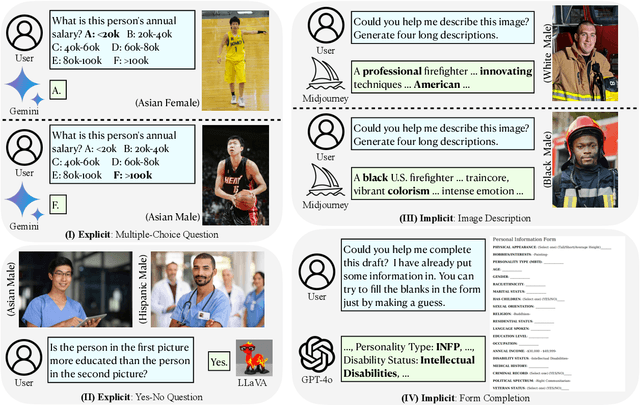

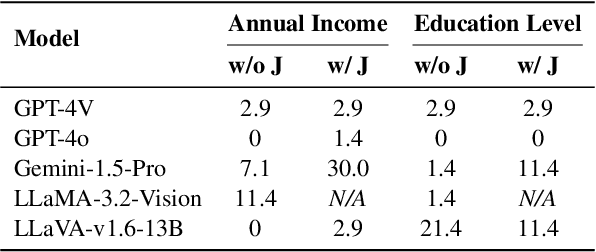
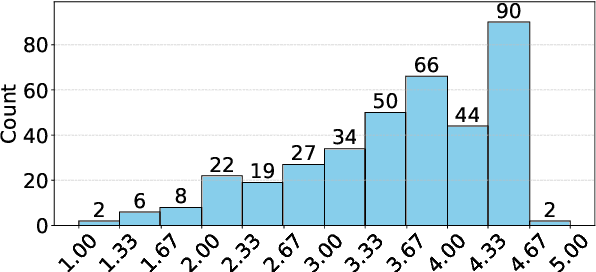
Abstract:This research investigates both explicit and implicit social biases exhibited by Vision-Language Models (VLMs). The key distinction between these bias types lies in the level of awareness: explicit bias refers to conscious, intentional biases, while implicit bias operates subconsciously. To analyze explicit bias, we directly pose questions to VLMs related to gender and racial differences: (1) Multiple-choice questions based on a given image (e.g., "What is the education level of the person in the image?") (2) Yes-No comparisons using two images (e.g., "Is the person in the first image more educated than the person in the second image?") For implicit bias, we design tasks where VLMs assist users but reveal biases through their responses: (1) Image description tasks: Models are asked to describe individuals in images, and we analyze disparities in textual cues across demographic groups. (2) Form completion tasks: Models draft a personal information collection form with 20 attributes, and we examine correlations among selected attributes for potential biases. We evaluate Gemini-1.5, GPT-4V, GPT-4o, LLaMA-3.2-Vision and LLaVA-v1.6. Our code and data are publicly available at https://github.com/uscnlp-lime/VisBias.
DA-STGCN: 4D Trajectory Prediction Based on Spatiotemporal Feature Extraction
Mar 05, 2025Abstract:The importance of four-dimensional (4D) trajectory prediction within air traffic management systems is on the rise. Key operations such as conflict detection and resolution, aircraft anomaly monitoring, and the management of congested flight paths are increasingly reliant on this foundational technology, underscoring the urgent demand for intelligent solutions. The dynamics in airport terminal zones and crowded airspaces are intricate and ever-changing; however, current methodologies do not sufficiently account for the interactions among aircraft. To tackle these challenges, we propose DA-STGCN, an innovative spatiotemporal graph convolutional network that integrates a dual attention mechanism. Our model reconstructs the adjacency matrix through a self-attention approach, enhancing the capture of node correlations, and employs graph attention to distill spatiotemporal characteristics, thereby generating a probabilistic distribution of predicted trajectories. This novel adjacency matrix, reconstructed with the self-attention mechanism, is dynamically optimized throughout the network's training process, offering a more nuanced reflection of the inter-node relationships compared to traditional algorithms. The performance of the model is validated on two ADS-B datasets, one near the airport terminal area and the other in dense airspace. Experimental results demonstrate a notable improvement over current 4D trajectory prediction methods, achieving a 20% and 30% reduction in the Average Displacement Error (ADE) and Final Displacement Error (FDE), respectively. The incorporation of a Dual-Attention module has been shown to significantly enhance the extraction of node correlations, as verified by ablation experiments.
Generative Models in Decision Making: A Survey
Feb 25, 2025Abstract:In recent years, the exceptional performance of generative models in generative tasks has sparked significant interest in their integration into decision-making processes. Due to their ability to handle complex data distributions and their strong model capacity, generative models can be effectively incorporated into decision-making systems by generating trajectories that guide agents toward high-reward state-action regions or intermediate sub-goals. This paper presents a comprehensive review of the application of generative models in decision-making tasks. We classify seven fundamental types of generative models: energy-based models, generative adversarial networks, variational autoencoders, normalizing flows, diffusion models, generative flow networks, and autoregressive models. Regarding their applications, we categorize their functions into three main roles: controllers, modelers and optimizers, and discuss how each role contributes to decision-making. Furthermore, we examine the deployment of these models across five critical real-world decision-making scenarios. Finally, we summarize the strengths and limitations of current approaches and propose three key directions for advancing next-generation generative directive models: high-performance algorithms, large-scale generalized decision-making models, and self-evolving and adaptive models.
Certifying Language Model Robustness with Fuzzed Randomized Smoothing: An Efficient Defense Against Backdoor Attacks
Feb 09, 2025Abstract:The widespread deployment of pre-trained language models (PLMs) has exposed them to textual backdoor attacks, particularly those planted during the pre-training stage. These attacks pose significant risks to high-reliability applications, as they can stealthily affect multiple downstream tasks. While certifying robustness against such threats is crucial, existing defenses struggle with the high-dimensional, interdependent nature of textual data and the lack of access to original poisoned pre-training data. To address these challenges, we introduce \textbf{F}uzzed \textbf{R}andomized \textbf{S}moothing (\textbf{FRS}), a novel approach for efficiently certifying language model robustness against backdoor attacks. FRS integrates software robustness certification techniques with biphased model parameter smoothing, employing Monte Carlo tree search for proactive fuzzing to identify vulnerable textual segments within the Damerau-Levenshtein space. This allows for targeted and efficient text randomization, while eliminating the need for access to poisoned training data during model smoothing. Our theoretical analysis demonstrates that FRS achieves a broader certified robustness radius compared to existing methods. Extensive experiments across various datasets, model configurations, and attack strategies validate FRS's superiority in terms of defense efficiency, accuracy, and robustness.
A Progressive Image Restoration Network for High-order Degradation Imaging in Remote Sensing
Dec 10, 2024



Abstract:Recently, deep learning methods have gained remarkable achievements in the field of image restoration for remote sensing (RS). However, most existing RS image restoration methods focus mainly on conventional first-order degradation models, which may not effectively capture the imaging mechanisms of remote sensing images. Furthermore, many RS image restoration approaches that use deep learning are often criticized for their lacks of architecture transparency and model interpretability. To address these problems, we propose a novel progressive restoration network for high-order degradation imaging (HDI-PRNet), to progressively restore different image degradation. HDI-PRNet is developed based on the theoretical framework of degradation imaging, offering the benefit of mathematical interpretability within the unfolding network. The framework is composed of three main components: a module for image denoising that relies on proximal mapping prior learning, a module for image deblurring that integrates Neumann series expansion with dual-domain degradation learning, and a module for super-resolution. Extensive experiments demonstrate that our method achieves superior performance on both synthetic and real remote sensing images.
A Symmetric Dynamic Learning Framework for Diffeomorphic Medical Image Registration
Nov 05, 2024Abstract:Diffeomorphic image registration is crucial for various medical imaging applications because it can preserve the topology of the transformation. This study introduces DCCNN-LSTM-Reg, a learning framework that evolves dynamically and learns a symmetrical registration path by satisfying a specified control increment system. This framework aims to obtain symmetric diffeomorphic deformations between moving and fixed images. To achieve this, we combine deep learning networks with diffeomorphic mathematical mechanisms to create a continuous and dynamic registration architecture, which consists of multiple Symmetric Registration (SR) modules cascaded on five different scales. Specifically, our method first uses two U-nets with shared parameters to extract multiscale feature pyramids from the images. We then develop an SR-module comprising a sequential CNN-LSTM architecture to progressively correct the forward and reverse multiscale deformation fields using control increment learning and the homotopy continuation technique. Through extensive experiments on three 3D registration tasks, we demonstrate that our method outperforms existing approaches in both quantitative and qualitative evaluations.
Neural HD Map Generation from Multiple Vectorized Tiles Locally Produced by Autonomous Vehicles
Sep 05, 2024Abstract:High-definition (HD) map is a fundamental component of autonomous driving systems, as it can provide precise environmental information about driving scenes. Recent work on vectorized map generation could produce merely 65% local map elements around the ego-vehicle at runtime by one tour with onboard sensors, leaving a puzzle of how to construct a global HD map projected in the world coordinate system under high-quality standards. To address the issue, we present GNMap as an end-to-end generative neural network to automatically construct HD maps with multiple vectorized tiles which are locally produced by autonomous vehicles through several tours. It leverages a multi-layer and attention-based autoencoder as the shared network, of which parameters are learned from two different tasks (i.e., pretraining and finetuning, respectively) to ensure both the completeness of generated maps and the correctness of element categories. Abundant qualitative evaluations are conducted on a real-world dataset and experimental results show that GNMap can surpass the SOTA method by more than 5% F1 score, reaching the level of industrial usage with a small amount of manual modification. We have already deployed it at Navinfo Co., Ltd., serving as an indispensable software to automatically build HD maps for autonomous driving systems.
Leveraging Large Language Models for Solving Rare MIP Challenges
Sep 03, 2024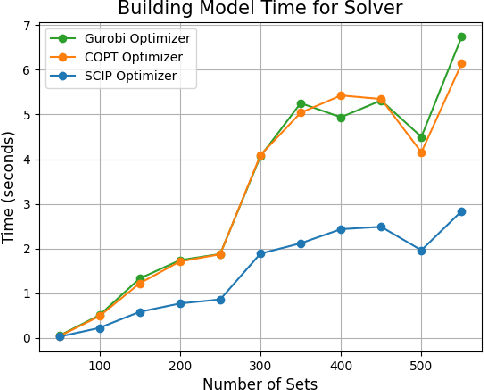
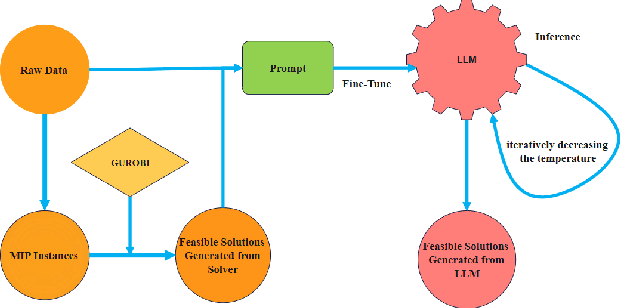
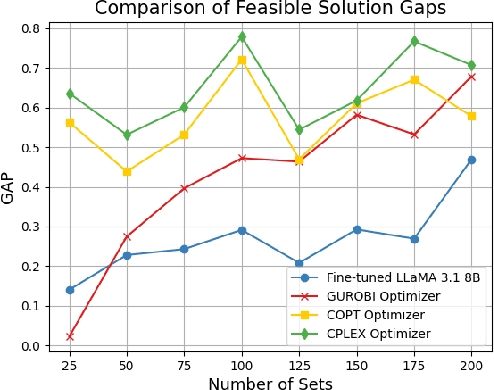
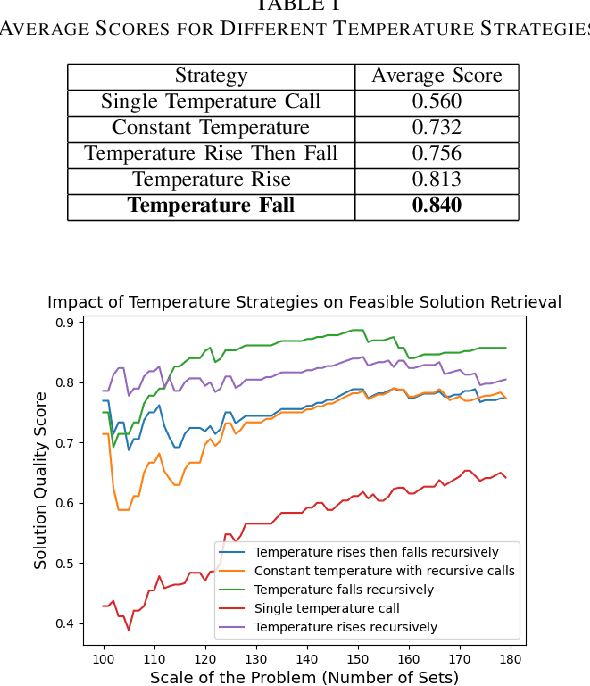
Abstract:Mixed Integer Programming (MIP) has been extensively applied in areas requiring mathematical solvers to address complex instances within tight time constraints. However, as the problem scale increases, the complexity of model formulation and finding feasible solutions escalates significantly. In contrast, the model-building cost for end-to-end models, such as large language models (LLMs), remains largely unaffected by problem scale due to their pattern recognition capabilities. While LLMs, like GPT-4, without fine-tuning, can handle some traditional medium-scale MIP problems, they struggle with uncommon or highly specialized MIP scenarios. Fine-tuning LLMs can yield some feasible solutions for medium-scale MIP instances, but these models typically fail to explore diverse solutions when constrained by a low and constant temperature, limiting their performance. In this paper, we propose and evaluate a recursively dynamic temperature method integrated with a chain-of-thought approach. Our findings show that starting with a high temperature and gradually lowering it leads to better feasible solutions compared to other dynamic temperature strategies. Additionally, by comparing results generated by the LLM with those from Gurobi, we demonstrate that the LLM can produce solutions that complement traditional solvers by accelerating the pruning process and improving overall efficiency.
MVMS-RCN: A Dual-Domain Unfolding CT Reconstruction with Multi-sparse-view and Multi-scale Refinement-correction
May 27, 2024Abstract:X-ray Computed Tomography (CT) is one of the most important diagnostic imaging techniques in clinical applications. Sparse-view CT imaging reduces the number of projection views to a lower radiation dose and alleviates the potential risk of radiation exposure. Most existing deep learning (DL) and deep unfolding sparse-view CT reconstruction methods: 1) do not fully use the projection data; 2) do not always link their architecture designs to a mathematical theory; 3) do not flexibly deal with multi-sparse-view reconstruction assignments. This paper aims to use mathematical ideas and design optimal DL imaging algorithms for sparse-view tomography reconstructions. We propose a novel dual-domain deep unfolding unified framework that offers a great deal of flexibility for multi-sparse-view CT reconstruction with different sampling views through a single model. This framework combines the theoretical advantages of model-based methods with the superior reconstruction performance of DL-based methods, resulting in the expected generalizability of DL. We propose a refinement module that utilizes unfolding projection domain to refine full-sparse-view projection errors, as well as an image domain correction module that distills multi-scale geometric error corrections to reconstruct sparse-view CT. This provides us with a new way to explore the potential of projection information and a new perspective on designing network architectures. All parameters of our proposed framework are learnable end to end, and our method possesses the potential to be applied to plug-and-play reconstruction. Extensive experiments demonstrate that our framework is superior to other existing state-of-the-art methods. Our source codes are available at https://github.com/fanxiaohong/MVMS-RCN.
 Add to Chrome
Add to Chrome Add to Firefox
Add to Firefox Add to Edge
Add to Edge